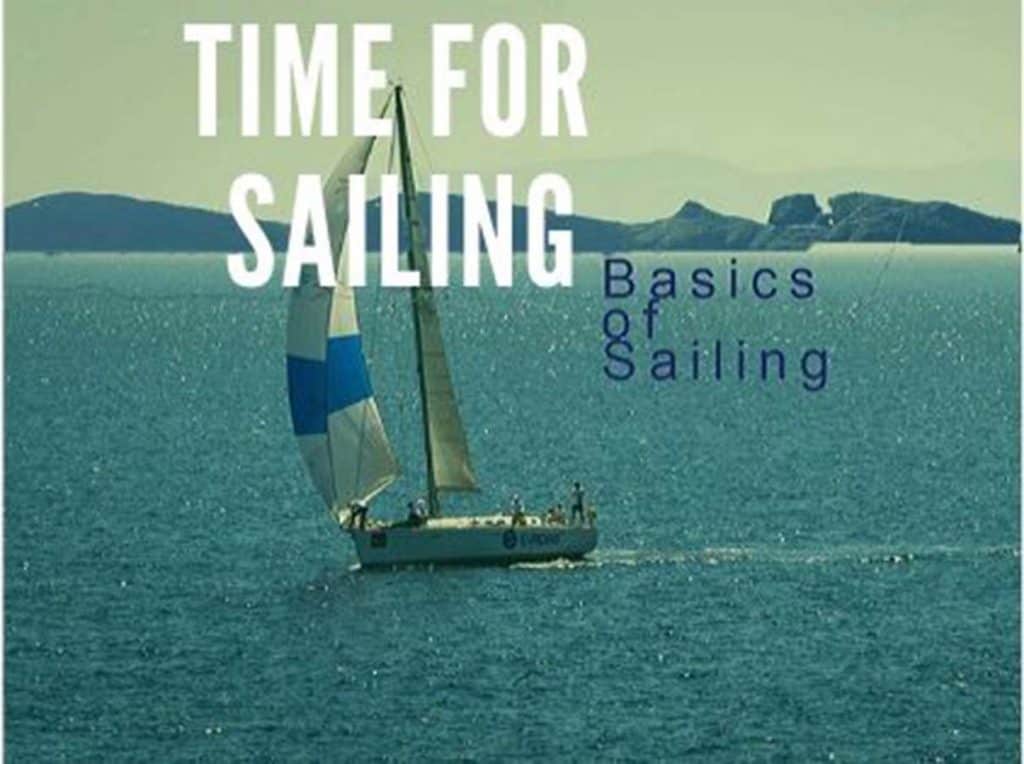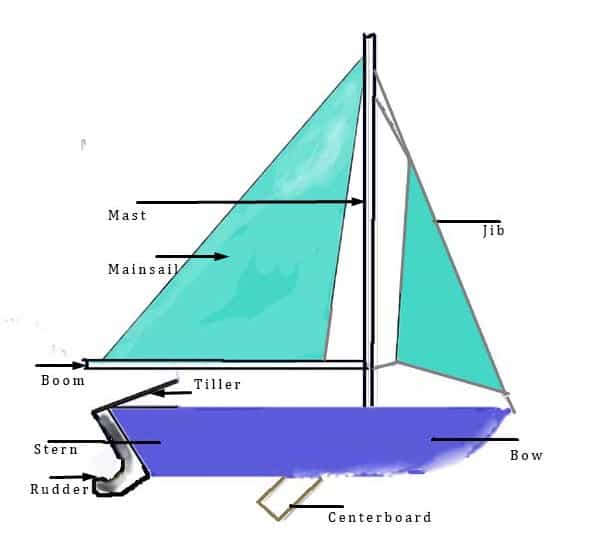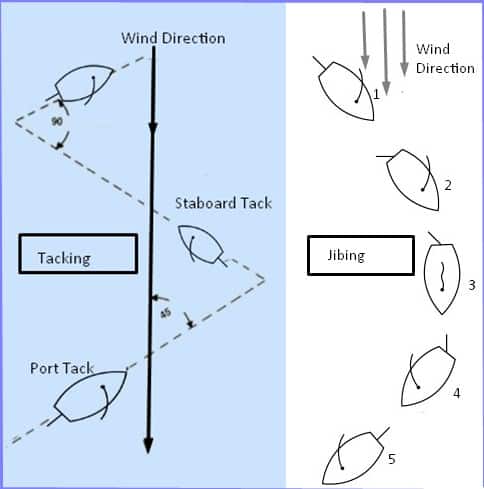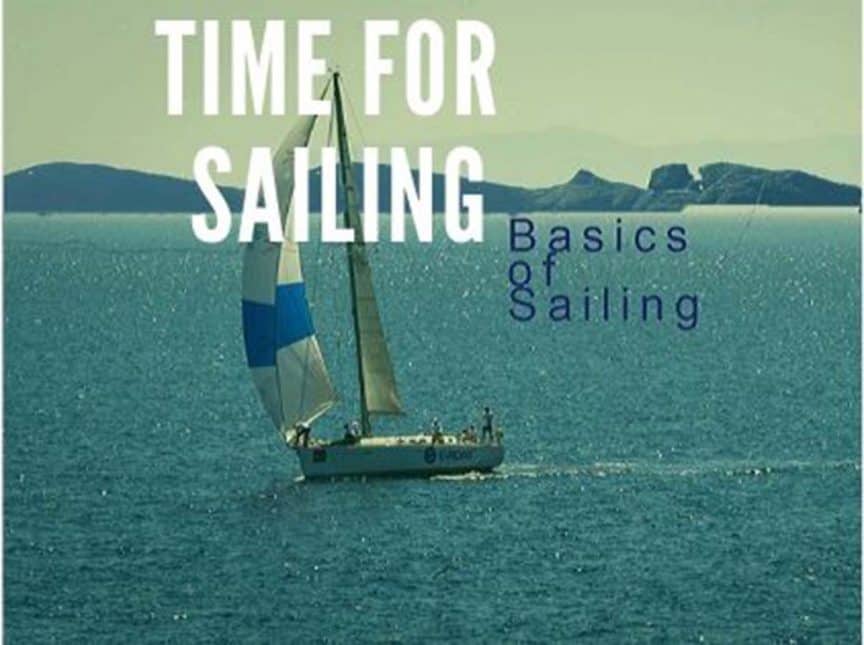Do you remember the first time you learned how to drive? How was it? Typically, most people find the terminologies regarding driving confusing. Sailing basics can also be confusing in the first days. But the practice will make you a master.
The car drivers also take some time before they can master the principles of driving and the traffic rules involved in every situation. After a few lessons and practicals, they soon ease in into it. Before long, driving becomes an instinctive skill.

Well, the same applies to sailing. If only you can take your time to understand a sailboat or a dingy, you will be halfway into becoming a pretty cool captain. Sailing requires a good understanding of your vessel and a few sailing principles. Don’t worry, you get the hang of it, and it will become a natural reflex. For starters, let’s understand some basic sailboat terms.
Parts of a Sailboat | Sailing Basics
The Aft and the Bow
Just like fish, a sailboat is streamlined. The bow is the front of the boat, and it is streamlined like the head of a fish. The aft is the back of the fish, and it is as flat as the tail of a fish. The aft is also referred to as the stern.

Sailboat Parts
The Port and the Starboard
The port and the starboard are the two structurally and functionally different sides of the bow. It is essential to tell the difference between the aft and the bow for the sake of locating the port and the starboard. If you cannot tell the difference between the port and the starboard, you’ll find major difficulty in maintaining balance when sailing. In fact, you could lose the direction or even sink your vessel.
The port is always on the left side of a sailboat’s bow. When out in the sea, right and left can become pretty abstract and relative. Therefore, sailors refer to the right side of the bow as the starboard and the left side of the bow as the port. The front is what matters most in forwarding movement and defining direction.
The Boom and the Rudder
The boom and rudder provide the speed control and steering functions of a sailboat, respectively. They are mechanical installations with which a sailor is able to control direction, velocity, and stoppage.
The boom is the horizontal pole extending from the base of the mast. It controls the mast and, consequently, the sails. You can use the boom to exploit wind power for moving forward or backward. You just need to adjust it either leeward or windward.
The rudder is always beneath the sailboat and in contact with water. It can be made from wood, metal, or fiberglass, and it must be flat.
Points of Sail
The point of sails on a sailboat refers to the boat’s direction in relation to the wind’s direction. It serves to harness the pushing and pulling power of wind for directional motion.
The Windward and the Leeward
The wind is a major driving factor in sailing. Wind energy majorly powers the motion and direction of a sailboat. As a sailor, you must always know the direction of the wind. The windward side refers to the direction in which the wind is blowing. Sailboats move in the direction of the wind and thus move windward.
The leeward side refers to the direction from which the wind is blowing.
Upwind and Downwind Sailing
Upwind sailing includes sailing towards the leeward, and it includes close-hauled and close reaching. Sailors refer to sailing across the wind as beam reaching. When a sailor moves in the windward direction, it is referred to as downwind sailing. The two types of downwind sailing include broad-reaching and running.
Points of sale apply to the port and the starboard identically. When a sailor wants to sail downwind, he should pull the sails tight and let them loose for upwind sailing. Between upwind and downwind sailing lies intricate wind angles that help sailors. They help in determining the vessel’s motional direction.
Sailing Principles
Side to Side Balance
You must always keep the port and starboard in balance and level. When picking up speed, your boat may incline to one side, and you must tip your weight on the opposite side to maintain a balance. When you incline your weight on one side, and the inclination persists, consider spilling some winds by altering the sails.
Boat Trim
You must also keep the bow and left at the level. Depending on the boat’s point of sail, you must keep moving towards or away from either the aft or the bow. While on a run, keep most of your weight on the aft/stern. When either aft or bow dip low in the water and the other part lifts, you lose a lot of speed through dragging.
Sail Setting
You must learn how to position the mainsheet for optimal efficiency. Your mainsheet shouldn’t flap; neither should it be too tight.
Choosing Appropriate Courses
You should always prefer the shortest and smoothest route to move from one point to another. When waves are crashing against your course, you may end up sailing in a curve if you persist on course stubbornly. Tides and leeway are very likely to steer you off course if you do not take caution.
Basics Of Sailboat Maneuvers
Heeling
When picking up speed from gusty winds, your boat will heel by inclining to one side. You need to keep port and starboard balance by tipping weight to the opposite side and spilling some wind.
Tacking
This maneuver includes changing direction by turning the front of the boat through the wind.

Basics of Sailing Tacking and Jibing
Jibing
This is also another direction changing maneuver, but it works with the opposite effect. It involves turning the stern of the boat against the wind.
Sailing license (USA & International)
Knowing the sailing basics will not do in all states in the USA. Very few states in the United States demand sailors to have sailing licenses. However, they do require that sailors be trained for safety and boats have the necessary safety standards and apparatus.
If you’d like to sail internationally, the rules are different. Since 2017, international sailors must have an International Sailing License. It requires license holders to be absolutely competent in steering lives and property across international waters. The great thing about the International Sailing License is that the United States of America recognizes it as a local sailing license.
How to Learn Sailing for Free
Sailing can be a very expensive skill to learn. You’ll need access to a boat for practice, and money to pay your sailing trainer. However, if you are smart and don’t have the money to spare, you can learn sailing for free. How now, you may be wondering?
For starters, learn the terminologies stated in this article. Visualize them and watch sailing movies. Then, go online and search for free sailing tutorials, guides, and manuals. Consume as much information as you can.
For the practical bit, just find charities that conduct activities by sailing. By volunteering your services to charities with boats, you can stay close to the sailors and ask them to let you practice. Within no much time, you’ll be a pro even if you couldn’t afford sailing classes.
Moreover, if you stay with a sailor you will be learning many tricks of sailing, small things (lifestyle), risks of sailing, good sides of sailing, etc. For example: if you don’t know how to use good sailing knives for maximum output, you can learn it gradually being with a sailor.
Final Words
Sailing is as surreal as life can get. Sailing is pretty much like driving, but it so much more liberating and exhilarating. Sailing basics will help you to get one step forward for sailing. It is one of those skills that grow into a fun and adventurous habits.
Furthermore, it can be quite an extra income earner. You should definitely try it for therapeutic and profitable reasons.



